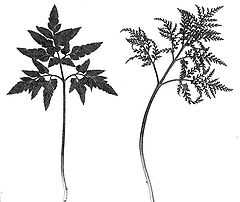Sceptridium dissectum
| Sceptridium dissectum | |
|---|---|
 | |
| Scientific classification | |
| Kingdom: | Plantae |
| Division: | Pteridophyta |
| Class: | Psilotopsida |
| Order: | Ophioglossales |
| Family: | Ophioglossaceae[1][2] |
| Genus: | Sceptridium |
| Species: | S. dissectum |
| Binomial name | |
| Sceptridium dissectum (Spreng.) Lyon 1905 | |
| Synonyms | |
| |
Sceptridium dissectum is a common fern (or fern-ally) in the family Ophioglossaceae, occurring in eastern North America. Like other plants in this group, it normally only sends up one frond per year. It has long been the subject of confusion because the frond presents in one of two forms, either the normal form (forma obliquum) that resembles other plants in the genus, or the skeletonized form (forma dissectum).
This is the most common grape fern throughout most of its range. It is a frequent denizen of disturbed lands, often growing with Diphasiastrum digitatum and Asplenium platyneuron. It has an unusual growing season, with the new frond emerging in July and dying back in May. The frond often turns from green to a bronze color during the winter.
Like other grape ferns, it depends on a mycorrhizal association in the soil.
References
- ↑ family Tropicos.org. Missouri Botanical Garden. 16 Jan 2012
- ↑ Christenhusz, Maarten J. M.; Zhang, Xian-Chun; Schneider, Harald (2011). "A linear sequence of extant families and genera of lycophytes and ferns" (PDF). Phytotaxa 19: 7–54.